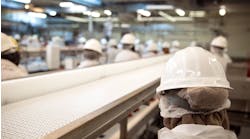Avoiding contamination is arguably "job one" for food manufacturers. There can be no quality in a food product if it mingles with pathogens or rubs shoulders with an undisclosed food allergen.
Operational procedures play a critical defensive role, but key battles are also won in the area of equipment cleaning and sanitation and in the hygiene of plant personnel. Oceans of water, barrels of chemicals and scalding heat are the traditional weapons of choice in the battle for cleaning efficacy, but in this age of lean and green, they are joined by more precise tools.
Clean-in-place systems not only drastically reduce the manual labor involved in cleaning procedures, they also can boost reliability. These systems rely primarily on nozzle and spraying technology designed specifically for the food material and equipment being used. So what are the most important considerations when choosing a spraying system?
"First and foremost the machine has to be effective — it must provide a thorough cleaning," says Jacqueline DeBellis, marketing manager at Gamajet Cleaning Systems Inc. (www.gamajet.com), Exton, Pa. "Next would be whether it is of a sanitary design."
That sanitary design threshold extends to all equipment, of course, and a relative assurance of it can be found in design standards such as 3-A, DeBellis says. Durability, ease of use and maintenance also need to be considered, she adds.
Spraying equipment companies go to great lengths to demonstrate that their systems provide spray patterns that will scour food from tanks, mixers and other equipment. For instance, Gamajet uses a rotary impingement technology that rotates the impact point of the spray, providing a repeatable, reliable cleaning pattern, the company says. The products often come with built-in or available validation features.
CIP systems have been in use for many years, but recent designs work at lower pressures, offering reductions in the use of water and cleaning materials. Further advances in that direction will come from technologies currently under development.
Studies show that among the top sources of food contamination are the hands (and feet) of plant employees. Surely, team members have bought in to efforts to eradicate such incidents, but sometimes the will to improve is just not enough.
This is where new technologies come into play. "Food plants are now required by regulation to have a hand washing station at the entrance to the production area," says Michele Colbert, vice president of sales and marketing at Meritech Inc. (www.meritech.com), Golden, Colo. "They can use a standard soap-and-sink station, or use our kind of equipment, but they can no longer use the disinfecting gels."
Meritech's touch-free hand washing stations provide full coverage in just 12 seconds. They cut water use by more than 80 percent and provide more control and predictability of soap usage.
"There is very little control with manual washing," she says. "There are so many variables. There is a standard — lathering for 20 seconds — but people miss spots. They tend to miss their thumbs or the backs of their hands."
Hand washing can use up to 3 gal. of water compared to 0.6 gal. for Meritech's CleanTech system, which uses rotating cylinders, each fitted with 40 spray nozzles, to ensure coverage. "It gets people to wash their hands more," Colbert says. "It feels like a little Jacuzzi for your hands."
Meritech provides plant staff with compliance data and with predictability on soap and water consumption. The company also offers foot baths (some work in concert with hand washing stations) and boot scrubbers for intense environments, such as meat plants.
For tools and implements, food plants typically turn to enclosed automated washing units, such as those offered by Douglas Machines Corp. (www.dougmac.com), Clearwater, Fla. "Most innovations [in washers] have been in terms of controls," says Kevin Lemen, vice president of sales and marketing. "What has emerged in the last year has been the desire/need for data logging of critical operating parameters, like wash temp, wash time, rinse temp, rinse time, and cycles completed, in an effort to create documentation." Douglas recently introduced a scale parts washer for scales used in snack manufacture.
For specialized cleaning, with zero water waste, food processors may want to look at dry ice systems, which blast surfaces with tiny frozen pellets. While such systems are not feasible for most everyday uses, dry ice systems, like those offered by Cold Jet LLC (www.coldjet.com), Loveland, Ohio, leave behind no wastewater, and will not add moisture to the cleaning environment.


